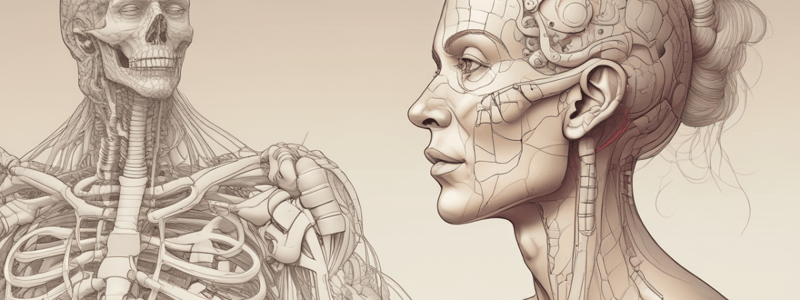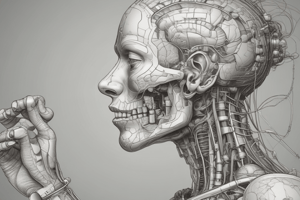Podcast
Questions and Answers
The larynx's main function is phonation.
The larynx's main function is phonation.
False (B)
The incidence of voice disorders is a measure of how commonly a disease or condition occurs in a population.
The incidence of voice disorders is a measure of how commonly a disease or condition occurs in a population.
False (B)
According to Roy et al.'s study, nearly 30% of respondents had never experienced a voice disorder in their lifetime.
According to Roy et al.'s study, nearly 30% of respondents had never experienced a voice disorder in their lifetime.
False (B)
Voice disorders can affect a person's academic performance.
Voice disorders can affect a person's academic performance.
Suprasegmental vocalization in babies includes laughing and cooing.
Suprasegmental vocalization in babies includes laughing and cooing.
Figures of incidence and prevalence in voice disorders are precise due to consistent definitions and methodologies.
Figures of incidence and prevalence in voice disorders are precise due to consistent definitions and methodologies.
Cohen et al.'s study found that nearly 7% of respondents had missed work for more than a month due to their voice disorder.
Cohen et al.'s study found that nearly 7% of respondents had missed work for more than a month due to their voice disorder.
Newborn infants are born with the ability to produce speech.
Newborn infants are born with the ability to produce speech.
According to the study in 2012, about 6% of patients received a diagnosis of dysphonia.
According to the study in 2012, about 6% of patients received a diagnosis of dysphonia.
Adults over the age of 70 years were more likely to be diagnosed with a voice disorder than those under age 70 years.
Adults over the age of 70 years were more likely to be diagnosed with a voice disorder than those under age 70 years.
Stemple's classification of voice disorders includes muscle tension voice disorders.
Stemple's classification of voice disorders includes muscle tension voice disorders.
Boone et al.'s classification of voice disorders includes congenital laryngeal pathologies.
Boone et al.'s classification of voice disorders includes congenital laryngeal pathologies.
Muscle Tension Dysphonia is a type of organic voice disorder.
Muscle Tension Dysphonia is a type of organic voice disorder.
Psychogenic voice disorders are related to structural deviations of the vocal tract.
Psychogenic voice disorders are related to structural deviations of the vocal tract.
Organic voice disorders are related to diseases of specific structures of the vocal tract.
Organic voice disorders are related to diseases of specific structures of the vocal tract.
Between 1% and 3% of school-age children may have a voice disorder.
Between 1% and 3% of school-age children may have a voice disorder.
What is the primary function of the larynx?
What is the primary function of the larynx?
What does the term 'incidence' refer to in the context of voice disorders?
What does the term 'incidence' refer to in the context of voice disorders?
What percentage of respondents in Roy et al.'s study had experienced a voice disorder at least once in their lifetime?
What percentage of respondents in Roy et al.'s study had experienced a voice disorder at least once in their lifetime?
What is an example of suprasegmental vocalization in babies?
What is an example of suprasegmental vocalization in babies?
Why are figures of incidence and prevalence in voice disorders not precise?
Why are figures of incidence and prevalence in voice disorders not precise?
What can be an impact of a voice disorder on an individual?
What can be an impact of a voice disorder on an individual?
What is a process of speech production?
What is a process of speech production?
What is a characteristic of voice disorders?
What is a characteristic of voice disorders?
What percentage of patients received a diagnosis of dysphonia according to the 2012 study?
What percentage of patients received a diagnosis of dysphonia according to the 2012 study?
What is the most common voice disorder seen in both children and adults?
What is the most common voice disorder seen in both children and adults?
What may occur as a result of continued misuse of the voice over time in Muscle Tension Dysphonia?
What may occur as a result of continued misuse of the voice over time in Muscle Tension Dysphonia?
What is the response of Muscle Tension Dysphonia to voice therapy?
What is the response of Muscle Tension Dysphonia to voice therapy?
What is a characteristic of Psychogenic Voice Disorders?
What is a characteristic of Psychogenic Voice Disorders?
What type of voice disorders are related to diseases of specific structures of the vocal tract?
What type of voice disorders are related to diseases of specific structures of the vocal tract?
What is the classification of voice disorders introduced by Stemple (2007)?
What is the classification of voice disorders introduced by Stemple (2007)?
What percentage of school-age children may have a voice disorder according to some researchers?
What percentage of school-age children may have a voice disorder according to some researchers?
Flashcards are hidden until you start studying
Study Notes
Voice Disorders
- Voice disorders can have a significant impact on an individual's life, affecting their academic, social, psychological, and vocational abilities.
Processes of Speech Production
- Respiration, phonation, resonation, articulation, and prosody are the five processes involved in speech production.
Anatomy and Physiology of Voice Production
- The larynx is responsible for phonation, airway protection, assisting in swallowing, and helping in activities that require highly elevated abdominal pressures.
Incidence and Prevalence of Voice Disorders
- The incidence and prevalence of voice disorders are not precisely known due to conflicting definitions, methodological differences, and varying patient populations.
- According to Roy et al. (2005), nearly 7% of respondents had a voice disorder at the time of the interview, and nearly 30% had experienced a voice disorder at least once in their lifetime.
- Cohen et al. (2012) reported that about 1% of patients received a diagnosis of dysphonia, with females being almost twice as likely as males to be diagnosed with dysphonia.
Classification of Voice Disorders
- Stemple (2007) classified voice disorders into congenital laryngeal pathologies, pathologies of the vocal fold cover, neurogenic laryngeal pathologies, and pathologies of muscular dysfunction.
- Boone et al. (2020) suggested a classification of voice disorders into muscle tension voice disorders, functional voice disorders, psychogenic voice disorders, and organic voice disorders.
Types of Voice Disorders
- Muscle Tension Dysphonia (MTD) is the most common voice disorder, resulting from overuse of the respiratory, laryngeal, and supralaryngeal systems, and can lead to secondary tissue changes.
- Psychogenic voice disorders can result from severe emotional trauma or conflict, leading to functional dysphonia or functional aphonia.
- Organic voice disorders are related to structural deviations or diseases of specific structures of the vocal tract.
Voice Disorders
- Voice disorders can have a significant impact on an individual's life, affecting their academic, social, psychological, and vocational abilities.
Processes of Speech Production
- Respiration, phonation, resonation, articulation, and prosody are the five processes involved in speech production.
Anatomy and Physiology of Voice Production
- The larynx is responsible for phonation, airway protection, assisting in swallowing, and helping in activities that require highly elevated abdominal pressures.
Incidence and Prevalence of Voice Disorders
- The incidence and prevalence of voice disorders are not precisely known due to conflicting definitions, methodological differences, and varying patient populations.
- According to Roy et al. (2005), nearly 7% of respondents had a voice disorder at the time of the interview, and nearly 30% had experienced a voice disorder at least once in their lifetime.
- Cohen et al. (2012) reported that about 1% of patients received a diagnosis of dysphonia, with females being almost twice as likely as males to be diagnosed with dysphonia.
Classification of Voice Disorders
- Stemple (2007) classified voice disorders into congenital laryngeal pathologies, pathologies of the vocal fold cover, neurogenic laryngeal pathologies, and pathologies of muscular dysfunction.
- Boone et al. (2020) suggested a classification of voice disorders into muscle tension voice disorders, functional voice disorders, psychogenic voice disorders, and organic voice disorders.
Types of Voice Disorders
- Muscle Tension Dysphonia (MTD) is the most common voice disorder, resulting from overuse of the respiratory, laryngeal, and supralaryngeal systems, and can lead to secondary tissue changes.
- Psychogenic voice disorders can result from severe emotional trauma or conflict, leading to functional dysphonia or functional aphonia.
- Organic voice disorders are related to structural deviations or diseases of specific structures of the vocal tract.
Studying That Suits You
Use AI to generate personalized quizzes and flashcards to suit your learning preferences.




